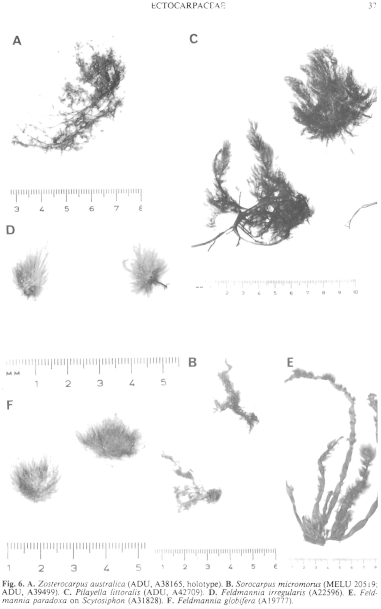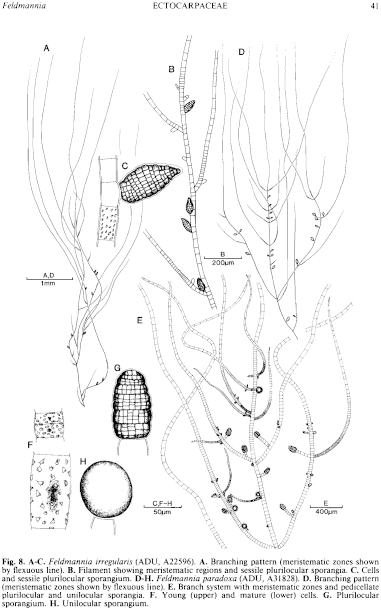|
|
|
|
|
|||||||||||
|
Electronic Flora of South Australia Species Fact Sheet
Phylum Phaeophyta – Order Ectocarpales
Selected citations: Clayton 1974: 763, fig. 11. Womersley 1967: 192.
Synonym
Ectocarpus paradoxus Montagne. Hamel 1931: 47, fig. 14. Knoepffler-Péguy 1970: 139, pl. 1, fig. 1.
Thallus (Fig. 6E) medium to dark brown, forming dense mucilaginous tufts 1–2 cm long, with numerous axes from the base, oppositely or alternately branched in their lower half with long unbranched filaments surmounting the meristematic regions (Fig. 8D); usually epiphytic. Filaments (Fig. 8E) (30–) 40–75 µm in diameter below with cells L/B (1.5–) 2–4 (–5), tapering to their apices if unbroken; laterals tapering when young. Growth from meristems (Fig. 8D,E) at the base of laterals and of the terminal filaments, with occasional other diffuse divisions (especially where sporangia occur). Cells (Fig. 8F) with numerous discoid phaeoplasts each with a pyrenoid, and centrally aggregated physodes.
Reproduction: Plurilocular sporangia (Fig. 8G) with a 1–3 celled pedicel (often longer than sporangium), alternate or often opposite another sporangium or lateral, ovoid to oblong and tapering only slightly, apex usually rounded to truncate, 60–120 (–140) µm long and (35–) 50–80 µm in diameter. Unilocular sporangia (Fig. 8H) subspherical to ovoid, sessile, 40–60 µm in diameter.
Type from Capraria, Italy; in PC.
Selected specimens: Kellidie Bay entrance, Coffin Bay, S. Aust. on Scytosiphon, lower eulittoral ( Womersley, 22.viii.1967; ADU, A31828). Point Riley, Spencer Gulf, S. Aust., on Cladostephus, upper sublittoral ( Womersley, 26.iii.1950; ADU, A13023). Flinders, Vic. (Clayton, 22.viii.1970; MELU, 21038).
Distribution: Widespread in temperate seas.
In southern Australia, from Kellidie Bay, Coffin Bay, S. Aust. to Flinders, Vic. (Clayton 1974, p. 764).
Taxonomic notes: F. paradoxa is fairly extensively branched in the lower half (as is F. irregularis) with numerous laterals each showing basal meristematic regions. The plurilocular sporangia do not taper markedly as in the latter species and are also pedicellate.
References:
CLAYTON, M.N. (1974). Studies on the development, life history and taxonomy of the Ectocarpales (Phaeophyta) in southern Australia. Aust. J. Bot. 22, 743–813.
HAMEL, G. (1931). Phéophycées de France. Fasc. I, pp. 1–80. (Paris.)
HAMEL, G. (1939b). Phéophycées de France. Fasc. V, pp. 337–432, i-xlvii. (Paris.)
KNOEPFFLER-PÉGUY, M. (1970). Quelques Feldmannia Hamel, 1939 (Phaeophyceae-Ectocarpales) des côtes d'Europe. Vie et Milieu Sér. A. 21, 137–188.
WOMERSLEY, H.B.S. (1967). A critical survey of the marine algae of southern Australia. II. Phaeophyta. Aust. J. Bot. 15, 189–270.
The Marine Benthic Flora of Southern Australia Part II complete list of references.
Publication:
Womersley, H.B.S. (14 December, 1987)
The Marine Benthic Flora of Southern Australia
Part II
©Board of the Botanic Gardens and State Herbarium, Government of South Australia
Illustrations in Womersley Part II, 1997: FIGS 6E, 8 D–H.

Figure 6 enlarge
Fig. 6. A. Zosterocarpus australica (ADU, A38165, holotype). B. Sorocarpus micromorus (MELU 20519; ADU, A39499). C. Pilayella littoralis (ADU, A42709). D. Feldmannia irregularis (A22596). E. Feldmannia paradoxa on Scytosiphon (A31828). F. Feldmannia globifera (A19777).

Figure 8 enlarge
Fig. 8. A–C. Feldmannia irregularis (ADU, A22596). A. Branching pattern (meristematic zones shown by flexuous line). B. Filament showing meristematic regions and sessile plurilocular sporangia. C. Cells and sessile plurilocular sporangium. D–H. Feldmannia paradoxa (ADU, A31828). D. Branching pattern (meristematic zones shown by flexuous line). E. Branch system with meristematic zones and pedicellate plurilocular and unilocular sporangia. F. Young (upper) and mature (lower) cells. G. Plurilocular sporangium. H. Unilocular sporangium.

|
Email Contact: State Herbarium of South Australia |

|